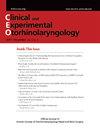甲状腺细胞中BRAFV600E突变的诱导导致频繁的高甲基化
IF 2.9
3区 医学
Q1 OTORHINOLARYNGOLOGY
引用次数: 2
摘要
目标。BRAFV600E突变是癌症的主要驱动突变。本研究的目的是阐明DNA甲基化与BRAFV600E突变诱导的甲状腺细胞基因表达变化之间的相关性。方法。我们使用通过用野生型BRAF基因(Nthy/WT细胞)和V600E突变型BRAF(Nthy/V600E细胞)转染Nthy/ori细胞产生的Nthy/BRAF细胞系。我们对Nthy/WT和Nthy/V600E细胞进行了基因表达微阵列和DNA甲基化阵列分析。整合两种类型的阵列数据,以确定甲基化和基因表达之间的反相关性。使用癌症基因组图谱(TCGA)的数据在计算机上验证了结果,并通过焦测序和定量实时聚合酶链反应(qRT-PCR)在体内验证了结果。后果在Nthy/V600E细胞中,199821个探针显著超甲基化,697个基因在Nthy/V600E中表现出“超甲基化下调”模式。包括肿瘤抑制基因和细胞凋亡相关基因。总共有66446个探针被显著低甲基化,227个基因在Nthy/V600E细胞中显示出“低甲基化上调”模式。包括原癌基因和发育蛋白编码基因。在TCGA分析中,491/697(70.44%)个基因表现出高甲基化下调模式,153/227(67.40%)个基因显示出低甲基化上调模式。10个选择的基因在焦磷酸测序和qRT-PCR中显示出相似的甲基化基因表达模式。结论甲状腺细胞BRAFV600E突变的诱导导致频繁的高甲基化。抗癌基因,如参与肿瘤抑制或凋亡的基因,通过上游高甲基化下调,而致癌基因,如原癌基因,通过低甲基化上调。我们的研究结果表明,甲状腺细胞中的BRAFV600E突变调节DNA甲基化,并导致癌症相关基因表达。本文章由计算机程序翻译,如有差异,请以英文原文为准。
Induction of the BRAFV600E Mutation in Thyroid Cells Leads to Frequent Hypermethylation
Objectives. The BRAFV600E mutation is a major driver mutation in papillary thyroid cancer. The aim of this study was to elucidate the correlation between DNA methylation and gene expression changes induced by the BRAFV600E mutation in thyroid cells. Methods. We used Nthy/BRAF cell lines generated by transfection of Nthy/ori cells with the wild-type BRAF gene (Nthy/WT cells) and the V600E mutant-type BRAF gene (Nthy/V600E cells). We performed gene expression microarray and DNA methylation array analyses for Nthy/WT and Nthy/V600E cells. Two types of array data were integrated to identify inverse correlations between methylation and gene expression. The results were verified in silico using data from The Cancer Genome Atlas (TCGA) and in vivo through pyrosequencing and quantitative real-time polymerase chain reaction (qRT-PCR). Results. In the Nthy/V600E cells, 199,821 probes were significantly hypermethylated, and 697 genes showed a “hypermethylation-downregulation” pattern in Nthy/V600E. Tumor suppressor genes and apoptosis-related genes were included. In total, 66,446 probes were significantly hypomethylated, and 227 genes showed a “hypomethylation-upregulation” pattern in Nthy/V600E cells. Protooncogenes and developmental protein-coding genes were included. In the TCGA analysis, 491/697 (70.44%) genes showed a hypermethylation-downregulation pattern, and 153/227 (67.40%) genes showed a hypomethylation-upregulation pattern. Ten selected genes showed a similar methylation-gene expression pattern in pyrosequencing and qRT-PCR. Conclusion. Induction of the BRAFV600E mutation in thyroid cells led to frequent hypermethylation. Anticancer genes, such as those involved in tumor suppression or apoptosis, were downregulated by upstream hypermethylation, whereas carcinogenic genes, such as protooncogenes, were upregulated by hypomethylation. Our results suggest that the BRAFV600E mutation in thyroid cells modulates DNA methylation and results in cancer-related gene expression.
求助全文
通过发布文献求助,成功后即可免费获取论文全文。
去求助
来源期刊
CiteScore
4.90
自引率
6.70%
发文量
49
审稿时长
6-12 weeks
期刊介绍:
Clinical and Experimental Otorhinolaryngology (Clin Exp Otorhinolaryngol, CEO) is an international peer-reviewed journal on recent developments in diagnosis and treatment of otorhinolaryngology-head and neck surgery and dedicated to the advancement of patient care in ear, nose, throat, head, and neck disorders. This journal publishes original articles relating to both clinical and basic researches, reviews, and clinical trials, encompassing the whole topics of otorhinolaryngology-head and neck surgery.
CEO was first issued in 2008 and this journal is published in English four times (the last day of February, May, August, and November) per year by the Korean Society of Otorhinolaryngology-Head and Neck Surgery. The Journal aims at publishing evidence-based, scientifically written articles from different disciplines of otorhinolaryngology field.
The readership contains clinical/basic research into current practice in otorhinolaryngology, audiology, speech pathology, head and neck oncology, plastic and reconstructive surgery. The readers are otolaryngologists, head and neck surgeons and oncologists, audiologists, and speech pathologists.

 求助内容:
求助内容: 应助结果提醒方式:
应助结果提醒方式:


